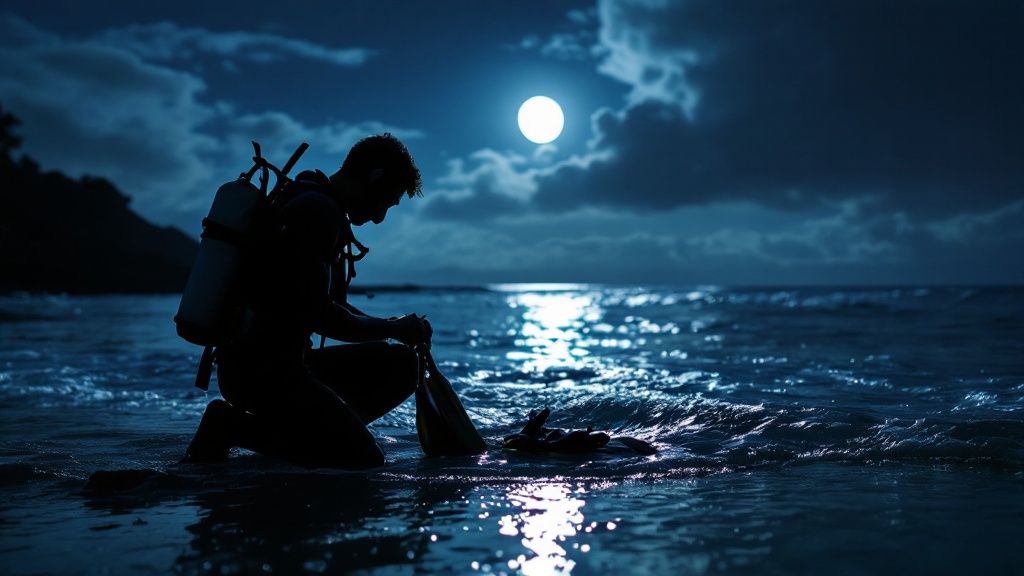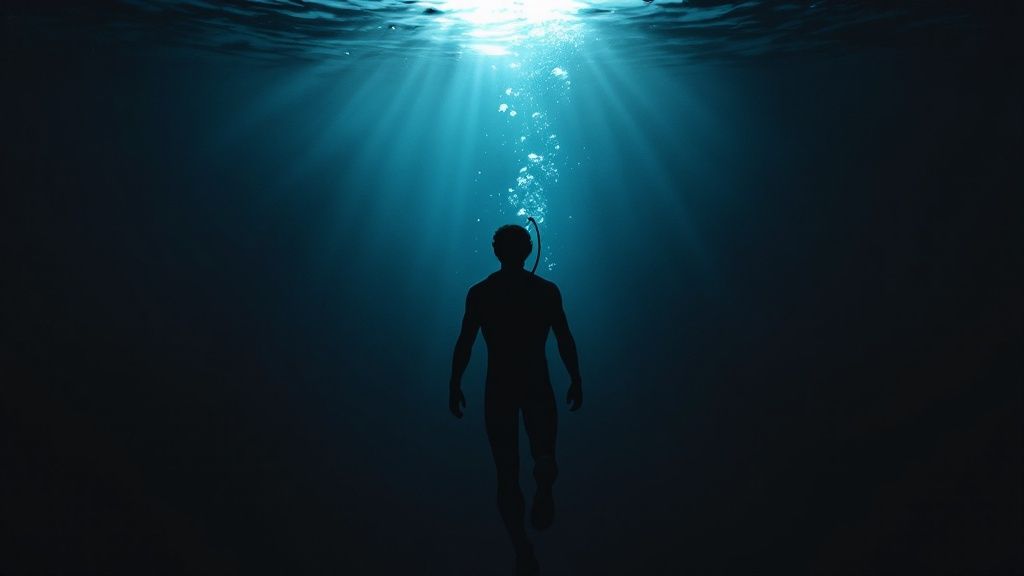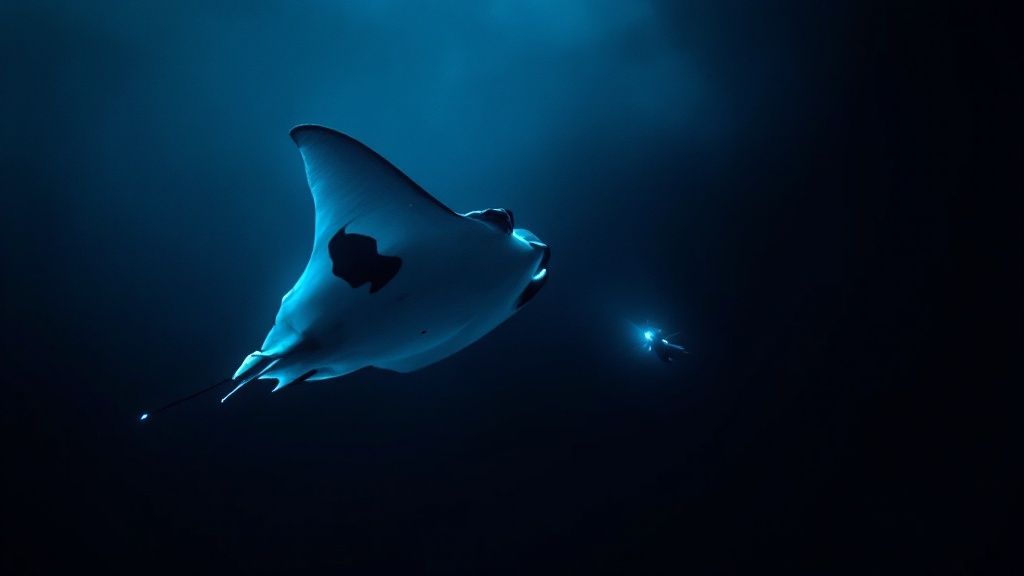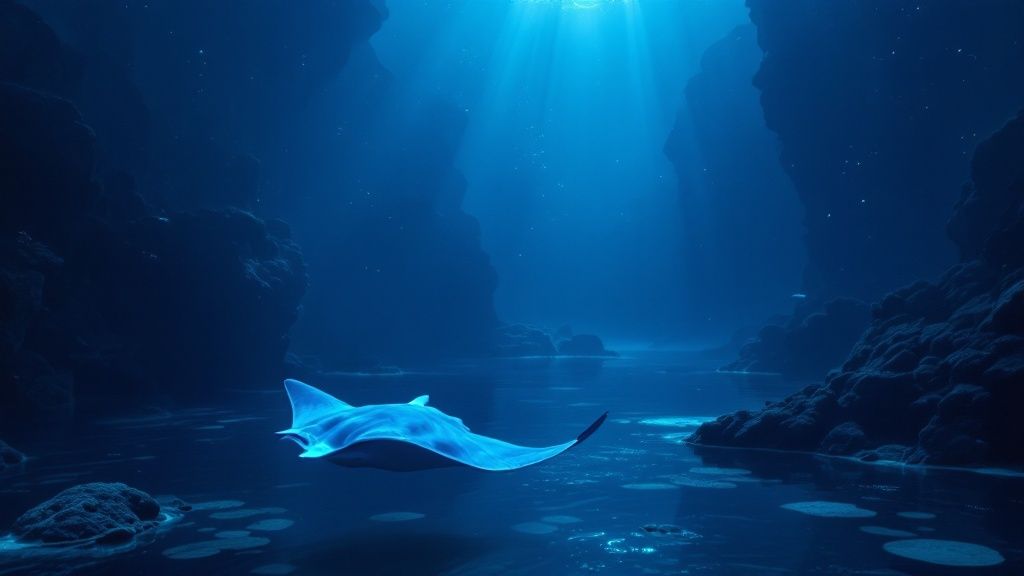The Mesmerizing World of Kona Manta Ray Night Snorkeling

The Kona manta ray night snorkel offers a truly special experience. Witnessing these gentle giants in their nocturnal habitat is an incredible opportunity. It's a breathtaking display, with the ocean's darkness illuminated by plankton and the graceful dance of the manta rays. This magical encounter results from a perfect combination of factors, making it an unforgettable experience for many. Learn more with this detailed guide on Manta Ray Night Snorkel Kona.
The Allure of the Night
The Kona manta ray night snorkel is distinctly different from daytime viewing. While manta rays might be seen gliding along the reef during the day, their behavior changes dramatically at night. Attracted by the lights that draw in plankton, their main food source, they engage in a captivating feeding display. This nighttime activity offers snorkelers a much more up-close and personal encounter. You might also be interested in: How to master the Manta Ray Night Snorkel on the Big Island.
A Thriving Ecosystem
The Kona Coast provides the perfect environment for manta rays. Its shallow bays are teeming with plankton, their primary food source. This plentiful food supply attracts a high concentration of manta rays, creating an ideal location for night snorkeling. In fact, Kona manta ray night snorkeling draws in over 80,000 visitors every year.
This surge in popularity is partially due to a 2020 law restricting dolphin interactions. This made manta ray snorkeling a desirable eco-friendly alternative. On busy nights, there can be up to 28 boats and over 170 people in the water. This underscores the importance of selecting responsible tour operators. The unique experience, with mantas illuminated by lights and bioluminescent plankton, offers a truly magical spectacle. Learn more about night snorkeling with manta rays.
From Obscure Adventure to Signature Experience
Once a relatively unknown activity, manta ray night snorkeling has become a quintessential Hawaiian experience. Several tour operators, like Kona Honu Divers, Manta Ray Night Snorkel Hawaii, and Kona Snorkel Trips, offer a variety of options. These range from small, intimate group excursions to larger boat tours.
Even well-established companies such as Captain Cook Snorkeling Tours have embraced the manta ray night snorkel. This further solidifies its place as a must-do activity. With this increased popularity comes a greater emphasis on responsible and ethical wildlife interaction. Preserving these magnificent creatures and their environment is crucial for the future of this unique and engaging experience.
Prime Locations: Where to Find Manta Magic

The Kona coast boasts incredible locations for a manta ray night snorkel. Two spots, Manta Village and Manta Heaven, are particularly well-known for reliable encounters. Choosing the right spot can truly elevate your experience.
Manta Village (Keauhou Bay)
South of Kona, near the Sheraton Keauhou Bay Resort, lies Manta Village. This spot is famous for consistent manta ray sightings. The shallow, protected bay provides an excellent feeding ground, attracting these graceful animals.
The shorter boat rides from Keauhou Bay are a plus, especially for those sensitive to seasickness. Minimize travel time and maximize your manta magic by booking with a local operator like Kona Honu Divers.
Manta Heaven (Makako Bay/Garden Eel Cove)
North of Kona, off the Kona International Airport coast, is Manta Heaven, sometimes called Garden Eel Cove. This location is popular for both daytime dives and manta ray night snorkels.
Manta Heaven may offer larger groups of manta rays, but sightings might be slightly less predictable than Manta Village. Still, the possibility of seeing multiple mantas feeding together is a significant draw. Manta Ray Night Snorkel Hawaii is one reputable tour operator offering excursions to this unique spot. They provide expert guidance, ensuring a respectful interaction with these gentle giants.
Choosing Your Ideal Location
Besides these two primary locations, there's a less-trafficked option off the Kohala coast near Kawaihae Harbor. This spot offers a more intimate experience with potentially smaller crowds.
However, manta ray sightings here are less frequent. This presents a choice: fewer people but fewer potential manta rays, or a more established location with higher chances of an encounter.
The best location for your manta ray night snorkel depends on your needs. Consider your swimming comfort, where you're staying, and how you handle boat rides.
Manta Village is an excellent option for a shorter trip and high probability of sightings. If you're hoping to see larger groups of manta rays and don’t mind a longer boat ride, consider Manta Heaven. Kona Snorkel Trips offers resources to help you choose the perfect tour. For a premium experience, consider Captain Cook Snorkeling Tours.
Historical data underscores the reliability of these locations. From 2009 to 2014, Manta Ray Advocates in Hawaii tracked individual manta rays at sites like Manta Heaven and Manta Village. This data helped understand manta ray movement and predict concentrations.
Annual reviews from 2011 to 2013 confirmed the consistency of sightings, making these locations reliable for manta ray encounters. More detailed statistics can be found here. This information solidifies these spots as prime locations for an unforgettable Kona manta ray night snorkel.
Selecting Your Perfect Manta Ray Night Snorkel Tour

Choosing the right manta ray night snorkel tour in Kona can be tough with so many options. This guide breaks down the key factors to consider, helping you find the perfect tour for an unforgettable experience. From understanding conservation efforts to assessing equipment quality, we'll cover everything you need to know. You might also be interested in our top 5 manta ray night dive tours.
Key Considerations When Booking
A few important factors separate the amazing Kona manta ray night snorkel tours from the average ones. First, consider the guide-to-snorkeler ratio. A smaller ratio means more personalized attention and increased safety.
Thorough safety briefings, experienced guides, and appropriate safety equipment are essential. Be sure to ask about the safety protocols each tour operator has in place.
Vessel comfort matters too. Think about the type of boat and its amenities. You might prefer a smaller, more intimate raft experience with Kona Honu Divers, or perhaps a larger catamaran with Captain Cook Snorkeling Tours suits your style. Finally, consider the operator’s conservation commitments. Responsible operators prioritize the well-being of the manta rays and their environment.
Equipment Quality
Good snorkel gear makes all the difference. Well-maintained masks, snorkels, and fins are a must. A properly fitted mask provides clear vision, while comfortable fins allow you to move easily in the water, letting you focus on the magnificent manta rays.
Some tours provide wetsuits or flotation devices for added comfort and confidence, especially for newer snorkelers. Be sure to ask what's included.
Manta Sighting Guarantees and Other Perks
While manta ray sightings are common, they aren't guaranteed. Jack's Diving Locker, for instance, boasts an 85-90% sighting success rate. However, manta rays are wild animals, and sightings depend on various factors, including weather and ocean conditions. Find more detailed statistics here.
Because of this, some operators offer a “Manta Guarantee.” Kona Snorkel Trips is one example. If you don't see mantas on your first trip, you can go again (based on availability).
Some tours offer extras like underwater photography packages, refreshments, or educational presentations about manta rays. These can add to the overall experience.
Price Points and Value
Price is a consideration, but focus on value. A slightly more expensive tour might be worth it for a smaller group size, better equipment, or a stronger commitment to sustainability. A premium Kona manta ray night snorkel experience is an investment in a truly memorable adventure. Manta Ray Night Snorkel Hawaii is a great resource for comparing various tour options.
To help you compare, here's a table summarizing key information about some popular tour operators:
Top Kona Manta Ray Night Snorkel Tour Operators
Comparison of popular tour operators offering manta ray night snorkel experiences in Kona
| Tour Operator | Group Size | Duration | Amenities | Price Range | Manta Guarantee |
|---|---|---|---|---|---|
| Kona Honu Divers | Small | Varies | Wetsuits, flotation | $$ | Check website |
| Captain Cook Snorkeling Tours | Larger | Varies | Refreshments | $$$ | Check website |
| Kona Snorkel Trips | Small | Varies | Manta Guarantee | $$ | Yes |
| Jack's Diving Locker | Varies | Varies | Manta Guarantee | $$ – $$$ | Yes |
This table highlights some key differences between operators, including group size, amenities, and whether they offer a manta sighting guarantee. Remember to check each operator's website for the most up-to-date information and pricing.
Preparing for an Unforgettable Manta Encounter

Getting ready for a Kona manta ray night snorkel turns nervous excitement into confident anticipation. A little preparation, both physically and mentally, makes all the difference. From understanding your comfort in the water to embracing the nighttime ocean, planning ahead enhances the experience.
Physical Preparation: Ensuring Comfort and Confidence
Getting physically ready is key to enjoying your manta ray snorkel. This includes practical steps like addressing potential seasickness. Consider motion sickness medication or acupressure wristbands before getting on the boat.
What you wear matters, too. Dress in layers, as the air temperature can cool down after the sun sets. While the water is warm, you might feel chilly after your snorkel. A light sweater or windbreaker is a good idea.
Preparing your body before you even get in the water is important. Staying hydrated, especially in Kona's climate, helps prevent cramps and maintains your energy. Practicing mindful breathing techniques can also help you relax once you're in the water.
If you haven't snorkeled in a while, practicing with your gear beforehand builds confidence and reduces anxiety. Try out your mask and snorkel in a pool or calm shallow water. Check out this guide on the best time of year to see manta rays in Kona.
Mental Preparation: Overcoming Anxieties
Night snorkeling can be a little intimidating for some. The darkness of the ocean can feel unsettling. But focusing on the magical aspects, like the bioluminescent plankton, helps ease those worries. Remember, experienced guides are there throughout the tour, ensuring your safety and comfort.
Addressing Physical Requirements and Adaptations
While some swimming ability is helpful, Kona manta ray night snorkeling can be adapted for different skill levels. Most tours provide flotation devices, such as pool noodles, which allow you to float comfortably while watching the manta rays. Some tours, like those from Kona Honu Divers, offer wetsuits and flotation vests for extra support. If you have any concerns about your swimming abilities, talk to the tour operator ahead of time.
Respectful Wildlife Interaction: Conservation in Action
Interacting responsibly with the manta rays is essential. Manta Ray Night Snorkel Hawaii offers great conservation guidelines. These emphasize the importance of not touching the mantas, as this can disrupt their protective mucous layer. Maintain a respectful distance, observe their natural behavior, and avoid chasing or trying to ride them.
Essential Packing List: Be Prepared
Packing the right gear enhances your Kona manta ray night snorkel. The table below lists essential items and recommended gear for a comfortable and successful experience.
Essential Packing List for Manta Ray Night Snorkel
| Item | Importance | Notes | Provided by Tour? |
|---|---|---|---|
| Towel | Essential | For drying off after the snorkel | Sometimes |
| Change of clothes | Recommended | Especially if you get cold easily | No |
| Reef-safe sunscreen | Important | Protect your skin and the coral reef | No |
| Motion sickness remedies | Optional | If prone to seasickness | No |
| Underwater camera | Optional | For capturing the experience | Sometimes (may be an additional cost) |
| Personal snorkel gear | Optional | If you prefer your own fit | Usually provided, but bring your own if preferred |
| Warm layer | Recommended | For after the snorkel | No |
Having these items ensures you're comfortable and ready to enjoy the experience. Remember to check with your specific tour operator about what they provide.
By following these preparation guidelines, you’ll be well on your way to an unforgettable and respectful Kona manta ray night snorkel. Choose a reputable operator like Captain Cook Snorkeling Tours or Kona Snorkel Trips for a high-quality adventure.
The Underwater Ballet: Your Manta Ray Encounter
Imagine a night snorkel in Kona, surrounded by manta rays. This guide walks you through a typical manta ray encounter, helping you prepare for this amazing experience.
Setting the Stage: Pre-Snorkel Briefing
Your adventure starts with a pre-snorkel briefing. Your guide, likely a seasoned pro like those at Kona Honu Divers, outlines the plan, emphasizing safety measures and proper manta ray etiquette. This briefing is essential for both your safety and the well-being of these magnificent creatures.
Guides also explain the special lighting used. These lights attract plankton, the manta rays' main food source, creating the perfect spot for the feeding display you're about to witness. This careful setup maximizes viewing while respecting the mantas' natural habitat.
Entering the Water: A World of Wonder
After the briefing, you'll enter the dark ocean, often using a flotation device. Guides position snorkelers around a central light, typically attached to a board or raft. This creates a stable viewing platform. Here's where the real magic unfolds.
The excitement builds as you await the manta rays. Soon, the first shadowy outlines appear from the depths, their graceful movements revealed by the underwater lights. The gentle giants of the deep come into view.
The Manta Ray Ballet: A Feast for the Senses
As the manta rays approach, their impressive size becomes clear. Wingspans of 10-16 feet are common. These majestic creatures glide through the water, performing a captivating feeding ballet. They execute mesmerizing loops and barrel rolls, their movements both powerful and graceful.
Floating still, you'll observe these gentle giants feeding just below you. The hypnotic rhythm of their movements and the ethereal glow of the plankton create an unforgettable experience. Guides often provide commentary, offering insights into manta ray behavior. For a different perspective, consider a manta ray night dive.
Identifying Individuals: Unveiling Unique Stories
Guides can often recognize individual manta rays by their distinct markings. Like fingerprints, these markings set each manta apart. This personal touch enhances the experience, making it even more meaningful.
Using these markings, guides share stories of individual mantas, their routines, and their role in the larger population. This deepens the encounter, transforming it from observation into a personal connection with these amazing animals. Companies such as Manta Ray Night Snorkel Hawaii and Kona Snorkel Trips specialize in these personalized experiences. Don't forget to check out other reputable providers like Captain Cook Snorkeling Tours.
Capturing the Magic: Photography in the Deep Blue
Want to remember your Kona manta ray night snorkel forever? Of course you do! This section explores how to capture the magic through photography and videography. We'll cover techniques to overcome the challenges of low-light, underwater conditions, so you can preserve these incredible memories. Check out our guide on Manta Ray Night Snorkel.
Mastering Low-Light Underwater Photography
Underwater night photography presents unique hurdles. The limited light requires special camera settings and techniques. A fast lens with a wide aperture (like f/2.8 or wider) is essential for capturing as much light as possible. A high ISO setting is also necessary, but be aware of potential noise, or graininess, in your images.
Mastering your camera's manual settings will give you more control. You can adjust the shutter speed, aperture, and ISO to find the sweet spot between brightness and image quality. Learning how to use the tour's lighting is also essential.
Working with the Tour's Lighting
The lights used to attract plankton also illuminate the manta rays. Positioning yourself strategically near these lights will dramatically improve your photos. However, avoid using your camera's flash directly on the mantas, as this can be disruptive.
Instead, use the ambient light from the tour's system. This softer, more natural light minimizes disturbance to the manta rays and creates beautiful results.
Underwater Housings and Filters
A good underwater housing protects your camera and makes it easy to use underwater. Some housings offer better ergonomics and button access. Red filters greatly improve the quality of night shots. They correct for the loss of red light underwater, resulting in more vibrant, accurate colors.
Video vs. Still Photography
Both video and still photography offer unique ways to capture the manta ray experience. Video captures the graceful movements and underwater ballet of the rays, while still photography freezes specific moments. A well-timed photo can highlight a manta ray's unique markings or impressive wingspan.
Choosing Tour Photo Packages
If you prefer to fully immerse yourself in the snorkel experience, consider a tour with professional photography services. Operators like Kona Honu Divers, Manta Ray Night Snorkel Hawaii, and Kona Snorkel Trips can connect you with tours offering this service. Alternatively, operators like Captain Cook Snorkeling Tours may have recommendations. This allows you to enjoy the moment without the pressure of capturing it yourself.
By considering these tips, you'll be ready to capture amazing images of your Kona manta ray night snorkel. Ready for an unforgettable adventure? Dive into the deep blue with Kona Honu Divers!
